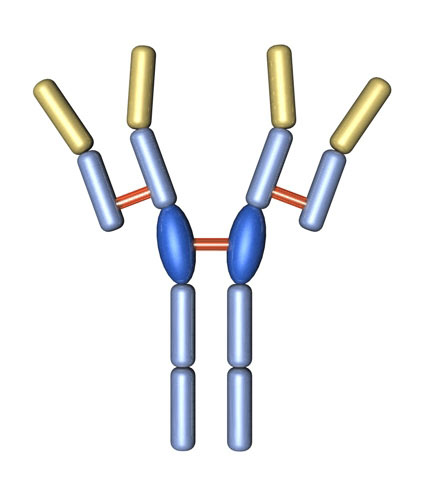
About allergies
Allergic reactions
An allergy is a misguided reaction to foreign substances by the immune system. It is said to be misguided because these foreign substances (called allergens) are generally harmless. A variety of cells play an important role in this type of reaction:
- T-lymphocytes recognize the foreign substances in the body and release chemical cytokines that stimulate the B-lymphocytes
- B-lymphocytes differentiate into plasma cells. These produce immunoglobulin E (IgE-antibody).
- Mast cells and basophiles (white blood cells) produce mediator chemicals such as histamine and leukotriene
Immunoglobulin E

Class E immunoglobulin (IgE) was first identified in 1964 and plays an important role in Type 1 allergic reactions. Everyone has IgE antibodies in small amounts to protect the body from parasites. However, allergic persons produce IgE in abnormally elevated quantities.
When stimulated by the appropriate foreign allergen, helper and suppresser cells (sub classes of the T-lymphocytes) stimulate B-lymphocytes to transform into Plasma-cells. Plasma-cells secrete antibodies of various classes which circulate in the blood and are responsible for immunity in the humours. If this regulation fails, a B-lymphocyte can also be converted by a normally harmless antigen. These immunoglobulins migrate via the blood stream to the basophiles and mast cells where they are bound to specific receptors within their Fc region. If the organism has further contact with the specific allergen, it migrates directly to the anchored IgE and links two neighbouring molecules with epitopes via the antigen-binding Fc region. This link formation liberates different vasoactive amines from the mast cells, which together with other highly active mediators can lead to the typical symptoms of a Type 1 allergic reaction.
The most common allergic conditions include hay fever (allergic rhinitis), asthma, allergic conjunctivitis, allergic eczema, hives (urticaria) and allergic shock (also anaphylaxis and anaphylactic shock).
Common allergy triggers

Airborne allergens
Airborne allergens include: pollen, animal dander, mites and mould. Often pet allergies are triggered by exposure to proteins found in animal skin cells, saliva or urine and are commonly associated with cats, dogs, horses and rodents. Inhaling mould spores can also cause an allergy with incidents typically reported between July and late summer. The most common triggers are Alternaria, Cladosporium, Aspergillus, Penicillium, Mucor and Rhizopus. A wide variety of tree, grass and weed pollen cause an allergic reaction, the intensity of which is influenced by pollen seasons, location, weather and other environmental factors.
Foods
For adults, the most common triggers of food allergies include shellfish, peanuts, tree nuts, fish and eggs, whereas young children tend to experience allergies to eggs, milk and peanuts. Food intolerance is often confused with food allergy as they share similar symptoms.
Insect venoms
Insect stings inject chemicals into the body which can cause allergic reactions, in most cases resulting from stings/bites from bees, wasps and fire ants. Mosquitos, flies and fleas can cause milder reactions.
Latex
Repeated or prolonged exposure to latex is one of the most common causes of allergic contact dermatitis. Normally harmless, latex is a natural rubber used in a wide range of items like medical supplies.
Medication
Some people develop allergies to certain medications, the most common of which include penicillin and related antibiotics. Reactions range from mild localized rashes or hives to life-threatening severe allergic reaction (anaphylaxis).
